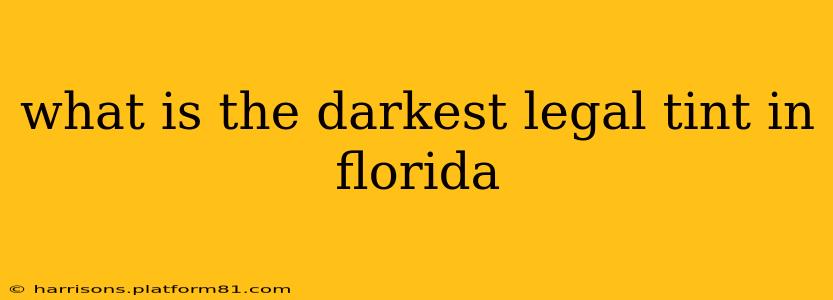Florida's window tint laws are notoriously strict, leaving many drivers wondering just how dark they can legally go. Understanding these laws is crucial to avoid costly tickets and potential legal issues. This guide will break down the specifics of Florida's window tinting regulations and answer some common questions.
Florida's Window Tint Law: The Basics
Florida Statute 316.291 governs window tinting. The law doesn't specify a percentage of visible light transmission (VLT) directly, but rather uses a more nuanced approach involving measurements. The key is understanding that the law defines acceptable limits through the use of a light meter that measures the percentage of light allowed to pass through the window.
What is the Light Transmission Percentage for Legal Tint in Florida?
While there isn't a single "darkest legal tint," the legal limit for the front side windows (front windshield and front passenger windows) is dictated by the amount of light permitted to pass through. The law requires a minimum of 28% VLT for these windows. This means at least 28% of the light must pass through, leaving the remaining 72% blocked. This is usually where most confusion arises.
What about the Back Windows?
For the rear side windows and rear windshield, Florida law is less restrictive. You can tint these windows as darkly as you wish. However, keep in mind that all rear windows must have a functional rear window defroster or a suitable alternative to ensure safety and visibility.
H2: Frequently Asked Questions (FAQs)
Here are some common questions about Florida's window tinting laws, answered to help clarify the issue:
H3: Can I use a tint that's darker than 28% VLT on my front side windows?
No. Using a tint darker than the 28% VLT requirement on your front side windows is illegal in Florida. Law enforcement can easily measure the VLT of your tint with a handheld device, resulting in a costly citation.
H3: What happens if I get caught with illegal window tint?
Getting caught with window tint that doesn't meet Florida's standards will result in a traffic ticket. The fines can vary depending on the county and the severity of the violation, but expect a hefty fine, and potentially points added to your driving record, affecting your insurance premiums.
H3: Are there any exceptions to Florida's window tinting laws?
There are some exceptions. Individuals with specific medical conditions may be granted exemptions, requiring documentation from a licensed physician. Also, certain vehicles, like limousines, may have different regulations. It's always best to check with your local Department of Highway Safety and Motor Vehicles (DHSMV) for details.
H3: How can I ensure my tint is legal?
The best way to ensure compliance is to have your tint professionally installed by a reputable shop. Reputable installers will be familiar with Florida's regulations and can help you choose a tint that meets the legal requirements. Always request certification confirming the tint's VLT complies with the law. Having this documentation can prove valuable if ever questioned by law enforcement.
H3: What about medical exemptions for window tint?
As mentioned, medical exemptions are possible. If you have a medical condition requiring darker window tint, you'll need a physician's statement attesting to the necessity. This needs to be presented to the authorities if your window tint is questioned.
Conclusion:
Understanding Florida's window tinting laws is crucial to avoid legal trouble. While the rear windows offer more flexibility, the front windows have strict regulations. Remember, a minimum of 28% VLT is required for the front windows, and exceeding this limit is illegal. Always prioritize safety and legal compliance when choosing window tint for your vehicle. Consulting with a reputable window tinting professional is always a smart choice to ensure that you stay within the limits of the law.
